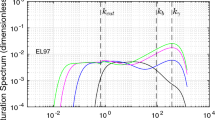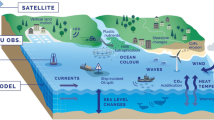Abstract
The paper starts with a discussion of the linear stochastic theory of ocean waves and its various nonlinear extensions. The directional spectrum, with its unique dispersion relation connecting frequency (ω) and wavenumber (k), is no longer valid for nonlinear waves, and examples of \(\left( \mathbf{k},\omega\right) \)-spectra based on analytical expressions and computer simulations of nonlinear waves are presented. Simulations of the dynamic nonlinear evolution of unidirectional free waves using the nonlinear Schrödinger equation and its generalizations show that components above the spectral peak have larger phase and group velocities than anticipated by linear theory. Moreover, the spectrum does not maintain a thin well-defined dispersion surface, but rather develops into a continuous distribution in \(\left( \mathbf{k,}\omega\right) \)-space. The majority of existing measurement systems rely on linear theory for the interpretation of their data, and no measurement systems are currently able to measure the full spectrum in the open ocean with high accuracy. Nevertheless, there exist a few low-resolution systems where data may be interpreted within a minimal assumption of a non-restricted \(\left( \mathbf{k,}\omega\right) \)-spectrum. The theory is reviewed, and analyses based on conventional spectral analysis as well as a directional wavelet analysis are carried out on data from a compact laser array at the Ekofisk field in the North Sea. The investigation confirms the strong impact of the second order spectrum below the spectral peak, but is non-conclusive about the off-set in the support of the first order spectrum seen in the dynamical simulations.





















Similar content being viewed by others
References
Allender J, Borgman LE, Vartdal L, Steinbakke P, Krogstad HE, Bjerken S, Barstow SF, Audunson T, Graham C (1989) WADIC project: a comprehensive field evaluation of directional wave instrumentation. Ocean Eng 16:505–536
Barrick E (1986) The role of the gravity-wave dispersion relation in HF radar measurements of the sea surface. IEEE J Oceanic Eng 11:286–292
Creamer DB, Henyey F, Schult R, Wright J (1989) Improved linear representation of ocean surface waves. J Fluid Mech 205:135–141
Donelan MA, Hamilton J, Hui WH (1985) Directional spectra of wind-generated waves. Philos Trans R Soc A 315:509–562
Donelan MA, Drennan WM, Magnusson AK (1996) Nonstationary analysis of the directional properties of propagating waves. J Phys Oceanogr 26:1901–1914
Dyachenko AI, Korotkevich AO, Zakharov VE (2004) Weak turbulent Kolmogorov spectrum for surface gravity waves. Phys Rev Lett 9:134501(4p)
Dysthe K (1979) Note on a modification to the nonlinear Schrödinger equation for application to deep water waves. Philos Trans R Soc A 369:105–114
Dysthe KB, Trulsen K, Krogstad HE, Socquet-Juglard H (2003) Evolution of a narrow-band spectrum of random surface gravity waves. J Fluid Mech 478:1–10
Forristall, GZ (2000) Wave crest distributions: observations and second order theory. J Phys Oceanogr 30:1931–1943
Fouques S, Krogstad HE, Myrhaug D (2007) A second order Lagrangian model for irregular ocean waves. J Offshore Mech Arct Eng 128:177–183
Glad IK, Krogstad HE (1992) The maximum-likelihood property of estimators of wave parameters from heave, pitch and roll buoys. J Atmos Ocean Tech 9:169–173
Goda Y (2000) Random seas and design of maritime structures. World Scientific, Singapore
Gramstad O, Trulsen K (2007) Influence of crest and group length on the occurrence of freak waves. J Fluid Mech 582:463–472
Grossman A, Morlet J (1984) Decomposition of hardy functions into square integrable wavelets of constant shape. SIAM J Math Anal 15:723–736
Hara T, Karachintsev AV (2003) Observation of nonlinear effects in ocean surface wave frequency spectra. J Phys Oceanogr 33:422–430
Hasselmann D, Dunckel M, Ewing JA (1980) Directional wave spectra observed during JONSWAP 1973. J Phys Oceanogr 10:1264–1280
Herbers THC, Elgar S, Sarap NA, Guza RT (2002) Nonlinear dispersion of surface gravity waves in shallow water. J Phys Oceanogr 32:1181–1193
Janssen PAEM (2009) On some consequences of the canonical transformation in the Hamiltonian theory of water waves. J Fluid Mech 637:1–44
Kahma K, Hauser D, Krogstad HE, Lehner S, Monbaliu JAJ, Wyatt LR (2005) Measuring and analysing the directional spectra of ocean waves. EU COST Action 714, EUR 21367, Brussels
Krasitskii VP (1994) On reduced equations in the Hamiltonian theory of weakly nonlinear surface-waves. J Fluid Mech 272:1–20
Krogstad HE (2001) Second order wave spectra and heave/slope wave measurements. In: Proc. Symp WAVES 2001, San Francisco, 2–6 September 2001
Krogstad HE, Donelan MA, Magnusson AK (2006) Wavelet and local directional analysis of ocean waves. Int J Offshore Polar Eng 16:97–103
Lake BM, Yuen HC (1978) A new model for nonlinear wind waves. Part 1. Physical model and experimental evidence. J Fluid Mech 88:33–62
Lindgren G (2006) Slepian models for the stochastic shape of individual Lagrange sea waves. Adv Appl Probab 38:430–450
Long RB (1980) The statistical evaluation of directional spectrum estimates derived from pitch/roll buoy data. J Phys Oceanogr 10:944–952
Longuet-Higgins MS (1963) The effect of non-linearities on statistical distributions in the theory of sea waves. J Fluid Mech 17:459–480
Masuda A, Kuo YY, Mitsuyasu H (1979) On the dispersion relation of random gravity waves. Part 1. Theoretical framework. J Fluid Mech 92:717–730
Mitsuyasu H, Kuo YY, Masuda A (1979) On the dispersion relation of random gravity waves, Part 2. An experiment. J Fluid Mech 92:731–749
Nazarenko S, Onorato M (2006) Wave turbulence and vortices in Bose-Einstein condensation. Physica D 219:1–12
Nieto Borge JC, Hessner K, Jarabo-Amores P, de la Mata-Moya D (2008) Signal-to-noise ratio analysis to estimate ocean wave heights from X-band marine radar image time series. IET Radar Sonar Navig 2:35–41
Onorato M, Osborne A, Serio M (2006) On the relation between two numerical methods for the computation of random surface gravity waves. Eur J Mech B 26:43–48
Phillips OM (1981)The dispersion of short wavelets in the presence of a dominant long wave. J Fluid Mech 107:465–485
Ramamonjiarisoa A (1974) Contribution a l’étude de la structure statistique et des mécanismes de génération des vagues de vent, Inst. Méc. de la Turbulence, Marseille, AO 10023
Ramamonjiarisoa A, Coantic M (1976) Loi expérimental de dispersion des vagues produites par le vent sur une faible longueur d’action. C R Acad Sci B 282:111–113
Ramamongiarisoa A, Giovanangeli J-P (1978) Observations de la vitesse de propagation des vagues engendrées par le vent au large. C R Acad Sci B 287:133–136
Tick LJ (1959) A nonlinear random model of gravity waves. Part 1. J Math Mech 8:643–651
Trulsen K, Kliakhandler I, Dysthe KB, Velarde MG (2000) On weakly nonlinear modulation of waves on deep water. Phys Fluids 12:2432–2437
Tucker MJ, Pitt EG (2001) Waves in ocean engineering. Elsevier Science & Technology, Oxford
Wang DW, Hwang PA (2004) The dispersion relation of short wind waves from space-time wave measurements. J Atmos Ocean Tech 21:1936–1945
WISE Group (2007) Wave modelling—the state of the art. Prog Oceanogr 75:603–674
Zakharov VE (1968) Stability of periodic waves of finite amplitude on the surface of a deep fluid. J Appl Mech Tech Phys 9:190–194
Acknowledgements
Field data from the laser array at the Ekofisk field in the North Sea are used by permission of ConocoPhillips Inc. Odin Gramstad was kind enough to carry out simulations with two higher order nonlinear models confirming the behavior we found from the Dysthe equation. Let us also on this occasion express our deepest thank to Professor Bjørn Gjevik for years of inspiration and collaboration.
Author information
Authors and Affiliations
Corresponding author
Additional information
Responsible Editor: John Grue
Rights and permissions
About this article
Cite this article
Krogstad, H.E., Trulsen, K. Interpretations and observations of ocean wave spectra. Ocean Dynamics 60, 973–991 (2010). https://doi.org/10.1007/s10236-010-0293-3
Received:
Accepted:
Published:
Issue Date:
DOI: https://doi.org/10.1007/s10236-010-0293-3




